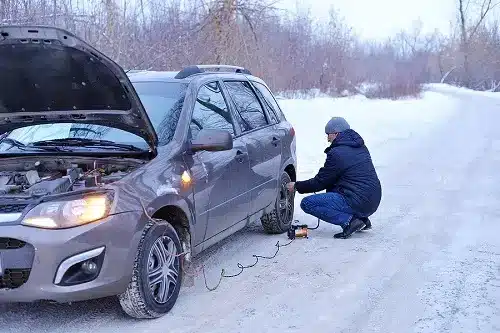Tire Pressure & Winter: Why Do Tires Go Flat in Cold Weather?
You might have already experienced going out in winter with tires having low air pressure. It’s an annoyance, as you need to refill the air.
Tire gong flat, however, seems to be a regular occurrence in frigid weather. The cold condenses the air, which reduces the air pressure.
As a matter of fact, a tire will lose about one pound per square inch for every 10-degree drop in temperature.
Tire Pressure Monitoring System vs. Tire Pressure Gauge

Vehicles manufactured after 2007 must have a tire pressure monitoring system (TPMS). It’s a safety system that tells you when a tire drops significant pressure while driving.
However, it would be best not to rely solely on TPMS to determine when your tires are low in air. TPMS only warns you when the tire pressure drops significantly. Instead, invest in a good tire pressure gauge or plan to stop by the tire repair shop at least once per month during winter.
When you stay on top of your tires, you’ll have less chance that a tire going flat in cold weather. If you have your air compressor but do not have a tire gauge, it’s best to invest now in a gauge made for tractors (wet and dry). It will last longer since it’s not prone to rusting.
How to Check Tire Pressure
Here are some steps & best practices you can do to measure your tire pressure:
- Always check the tire pressure when the vehicle is cold. If you have just driven your tires, you will get an inaccurate reading as the resistance between the tires and the road heats the air inside the tires and increases air pressure.
- Always choose a quality tire pressure gauge, or you’ll get inaccurate readings. Remove the cap from the valve stem. Press the pressure gauge onto the valve stem firmly until you do not hear air hissing. If you hear air hissing, it’s not on tight enough, and you’re letting air out of the tire.
- Read the gauge. Most passenger vehicles require 32 to 40 psi unless you have run-flat or low-profile tires. Most trucks require around 42 to 45 psi. You can find the recommended air pressure on the tire’s sidewall.
Got Tire Pressure Issues? Visit Little Wolf Automotive in Antigo, WI
If the air pressure is low, you can top off the tires yourself if you have an air compressor at home. Or bring the vehicle into Little Wolf Automotive in Antigo, WI. We can help you not only in checking the pressure but also topping off the tires as required.
If you are unsure whether the cold or a puncture causes the low tire pressure, we can also check for a puncture once we air up the tire. If a tire has a puncture in the tread, we can repair it with a plug or patch. But you’ll need a new tire if the hole is in the sidewall.
For tire services, call us at (715) 350-4287. We are conveniently located at 1436 Neva Rd, Antigo, WI 54409.





